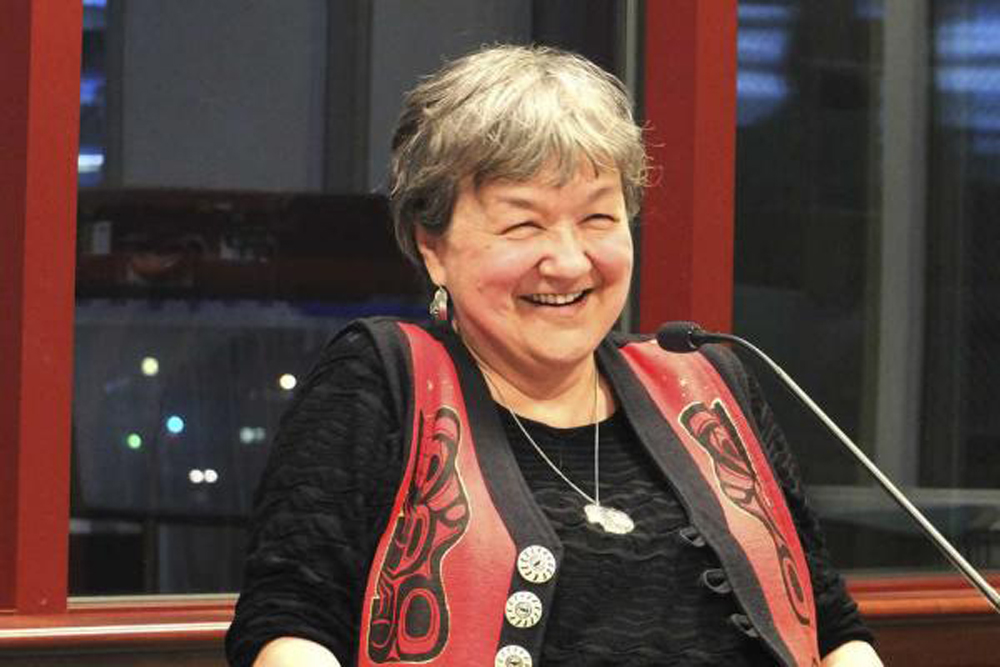“Blonde Indian: An Alaska Native Memoir” by Ernestine Hayes. 173 pages, 2006, University of Arizona Press, $16.95
Ernestine Hayes’ genre defying debut takes its shape from the many braided rivers of Lingit Aani — the Taku, Stikine and Naas. Part prayer, part tragedy and part triumph, “Blonde Indian” presents a memoir in which the story of person cannot be separated from the story of place. Beginning in territorial-era Juneau, the setting is familiar and full of landmarks still present today (Village Street, the Governor’s Mansion). Depictions of the discrimination, poverty, alcoholism and abuse Hayes experienced typify the fierce honesty with which her story is told.
Rooted in the landscape of Southeast Alaska, a place of bounty and natural cycles, it’s a story of returning, and is full of resilient beauty and hope. When asked about the book’s form, which weaves memoir, fiction, clan stories and natural history, Hayes has remarked, “There is a difference between truth and fact.” As the narrative shifts point of view, time, and lyric tone, it begins to appropriately take on a nonlinear shape, like memory. The lives of Hayes and character Tawnewaysh (Tom), though told with distinctly different voices, have strong narrative parallels. Both are removed from their childhood homes, sent to Christian boarding schools where they are irrevocably changed, then leave Alaska, each to battle in their own wars before returning. Tom joins the army, Hayes leaves Juneau with her mother to “wander in a dark forest called California.” Following an abusive marriage, attempted suicide and years of homelessness, Hayes, like the salmon, seeks to return to the place of her birth.
We see Hayes as a child living in Juneau’s Indian Village experiencing her mother’s battle with tuberculosis through the windows of St. Anne’s Hospital. We witness her alienation as a Native girl among white classmates. Her mother’s absence leads to strong, close relationships with her grandmother and also with her aunt Erm. These characters come to represent Hayes’ conflicted identity as part Tlingit, part other.
Hayes uses clan stories effectively (Raven Steals the Light, Chookeneidi, singing clan history to an unborn child, Kóoshda Káa) to introduce general readers to Tlingit values and concepts (reincarnation, community well being, respect for the spirit of all things). Subtle exploration of the gaps she sees in clan stories are a way to contemporize them to emphasize a living culture: “but it hasn’t been told what Raven’s mother sang to him when he was in her belly.” In placing Raven in the present she suggests an answer to her own question, “sometimes the lessons the child learns before it is pushed out into an unfriendly word are depression, misery, puke … These are the scars with which Raven now is born.”
Descriptions of food gathering and preparation are repeated throughout the book, emphasizing the contrast between Native foods and a growing dependence on store-bought cuisine with imposed restrictions on subsistence activities. Moments where Hayes reflects on the significance of Native foods in her life are poignant and complex, “I miss the food of my childhood. I can neither gather or prepare those old Native staples. I miss my grandmother’s voice….I wander down the aisles of my childhood searching for gumboots and berries. I fill my basket with sugar and bread and carry it home, where I sit alone in my room, hungry for dryfish.”
In one repeated scene, Hayes accompanies her uncles on a deer hunt over the bridge on Douglas island, riding in a wheelbarrow that they use to cart home the animal. The introduction of new regulations on subsistence activities imposes the concept of poaching onto the story. In another scene, upon learning that her classmate has decorated a birthday cake, Hayes is, “as amazed as though I’d been told she could fly. It was one more secret thing that only people who were different from me knew how to do: unknowable, enchanted people who prepared and ate unknowable, enchanted food.”
Familiar brands are listed to reinforce this concept of colonialism through food, “Tang, Spam and pilot bread.” In the poem “Brand Names” (Yellow Medicine Review, Spring 2015), Hayes again digs into the impact food has had on her identity, “We shopped for mail-order acceptance following send-away instructions. / We searched for our mislaid culture in shelved boxes of pilot bread. / Sailor Boy, Tang, Libby’s corned beef—traditional foods / of our colonized cupboard.”
With “Blonde Indian,” which was honored with the American Book Award in 2007, Hayes has created a conflicted piece of art. As it celebrates Tlingit culture, the strong connection between the people, this magnificent land, the animals and the spirits, it also brings to light the historic and contemporary fallout of colonialism and racism. The structure of the book will challenge many and the content will confront others, but all readers will find they are changed by the experience.
•••
“Blonde Indian: an Alaska Native Memoir” is the 2015-16 UAS One Campus, One Book and the 2016 Alaska Reads selection. On Wednesday, Nov. 4, Hayes will moderate a panel featuring contributors to the video game, “Never Alone” (Kisima Ingitchuna), the first game developed in collaboration with the Iñupiat, an Alaska Native people. On Friday, Nov. 6, during UAS’ Evening at Egan event, Hayes will discuss her memoir and present the talk, “An Animate World.” She will also lead a free community writing workshop emphasizing memoir at the new Valley Library on Saturday Nov. 14.
The pre-publication manuscript for Blonde Indian including author correspondence and notes is in the archives at the UAS Egan Library, a digital version is available online in ScholarWorks@UA, https://scholarworks.alaska.edu/handle/11122/5810
• Jonas Lamb is a librarian and poet currently enrolled in the low-residency MFA program through UAA. He lives in Juneau in a 100-year-old house with his wife, two sons, and two dog spirits. He enjoys skiing, hockey, baseball, kayaking and getting lost in a good book.

